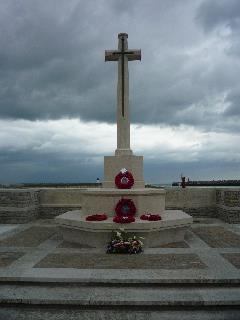
4 minute read
A Pilgrimage To The Front Lines
I would like to remind members of the Branch that on September 20th, the Northern Ireland (N.I.) veterans association will be holding an anniversary parade for all N.I. veterans at the National Memorial Arboretum in Staffordshire. We attended, as an association, for the inaugural event. So far approximately 20 of our members are going to attend this year’s parade. I have placed on our Branch web page and Facebook page details of accommodation (both hotel and B&Bs) within the local area and these details also include a local campsite should anyone wish to camp in case local hotels are full. Photographs of the future events will follow in the next issue of the e-zine.
In November, our Branch main event will be Remembrance Weekend, with many people arriving on Friday 7th and staying over until Monday 10th November. The venue for the main event on Saturday 8th November has not yet been confirmed but will be next month and the relevant information will be posted on our web page. The advance party usually congregate at the Queen Vic Hotel on Friday and the Post Parade Lunch on the Sunday will be held at The Best Western Roker Hotel. Details of some available accommodation are on our web page/facebook page but please book early to avoid disappointment for both event tickets and hotels. Entry to the function is by ticket only purchased in advance. No tickets can be bought on the night or at the door.
Advertisement
Looking forward to seeing you all at Winchester!
Malcolm Donnison North East Branch Editor
Major General Sir Michael Carleton-Smith CBE,DL. As the ferry enters the port at Calais, one sees at the end of the pier on the starboard side, a lone stone cross.
Each May a party from the Royal Green Jackets attend a service there to remember their brother riflemen in the Queen Victoria’s Rifles, The King’s Royal Rifle Corps and the Rifle Brigade who fought and died there to defend Calais and prevent the German panzer divisions disrupting the evacuation of the British Expeditionary Force from Dunkirk in 1940. Penny and I are regular attenders and meet up with about eight French Colour bearers, the Mayor of Calais, the British Consul, buglers, this year 7 Rifles’ Padre and the Vicar of Bow, with two of her churchwardens and her riflemen parishioners, some loyal French and about sixty mostly retired members from the three former regiments. It is a moving and memorable occasion.
Also this year Penny and I repeated a commemoration trip to Ypres where my father was badly wounded 99 years ago, shot through the neck by a German sniper. He was a regular subaltern in the King’s Dragoon Guards, which had come from India in the Lucknow Brigade of the First Indian Cavalry Division. He recovered, though was always paralysed in his right hand, but this did not hinder him from serving in the Third Afghan War in 1919 and being involved with the Jedburgh agents of SOE (Special Operations Executive) in the Second World War, for which he was awarded the Croix de Guerre, the Legion d’Honneur and the American Medal of Merit. Penny also had two twenty-year-old uncles killed at Arras, one of whom had already served in Gallipoli where one of my great uncles had been killed. None of these young uncles have known graves.
We arrived in Ypres in time to attend Evensong in St George’s Memorial Church with the walls packed with regimental, formation, individual and even school memorials. A plaque outside the entrance reads:
Ye who would enter here to worship God Think of your brothers who before you trod This hallowed ground and did not grudge to give Their lives in war that you might live Ask for a heart to follow their way Of sacrifice and duty. - Rest and pray.
We twice attended the historic Last Post Ceremony at the Menin Gate, sounded every night at 8.00pm since 1928. We were in the company of about a thousand people on each deeply moving occasion. We visited cemeteries and memorials immaculately maintained by the Commonwealth War Graves Commission, whose regional offices we visited in Ypres to discuss the only exception we found. I had spent two years on exchange with The Rifle Brigade’s famous allied regiment the Princess Patricia’s Canadian Light Infantry and we found their memorial at Frezenberg, which they will visit on the centenary of the battle next year, to be in need of attention. We were reassured that ‘it’s all in hand’.

Many of the identical white unnamed gravestones have ‘A soldier of the Great War’ and beneath a cross, is engraved – ‘Known unto God’ . There are many moving inscriptions below the regimental badge on the named gravestones. Rifleman J. Taylor’s gravestone, died 31st July, 1915, has the wording;
‘Roses may wither, leaves fade and die. Friends may forget you but never shall I.’
The big memorials list those who have no known grave; 54,900 on the Menin Gate and a further 34,888 at Tyne Cot, near Passchendaele, all from the dreaded Ypres Salient. The town, with its beautiful 13th Century Cloth Hall, was almost totally destroyed in four years of shelling and was memorably restored after the war and is today a charming little Belgian town with a completely rebuilt Cloth Hall containing ‘The Flanders Fields Museum’.

Volume 6 Issue 1 | 40 We also visited ‘Toc H’ (Talbot House), the well preserved little town house behind the lines in Poperinghe (‘Pops’), where the Reverend Tubby Clayton set up his Rest Centre, with a simple chapel in the attic, redolent with heartrending memories. There was the inscription,
‘There are many kinds of sorrow in this world of love and hate. But there is no sterner sorrow than a soldier’s for his mate.’










